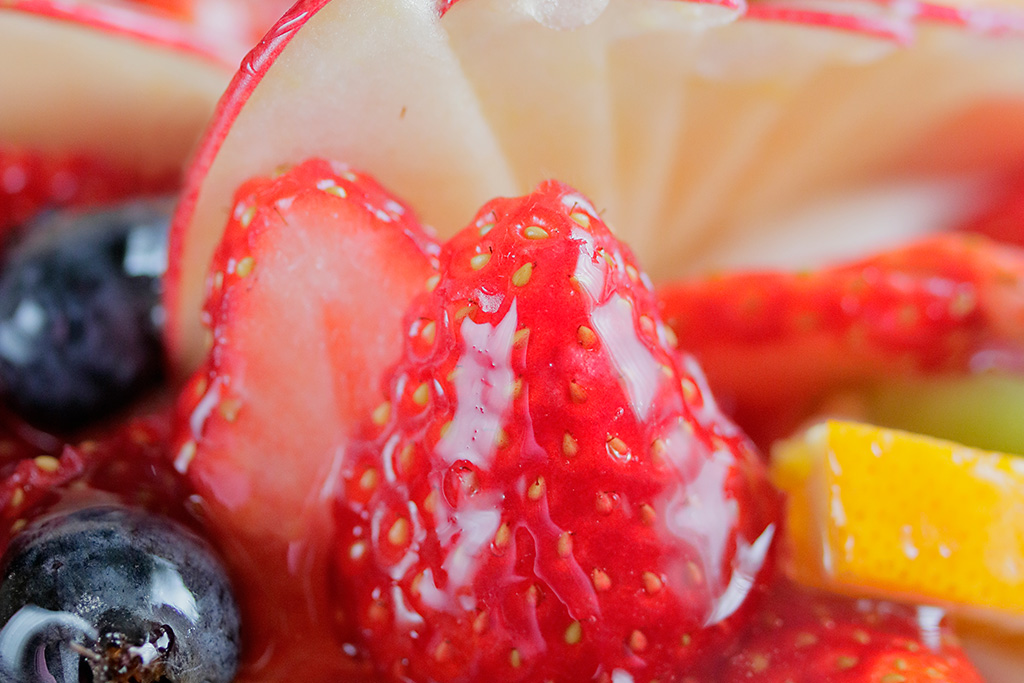Macro Lens Techniques – Get Fresh, Appetising Pictures of Tarts & Pastries
A brilliant, mouth-watering pastry adds sparkle to any table. To capture such an image, I recommend getting a close up shot by using a macro lens. If you capture the beautiful gloss which varies with the light, you can make the shot shine and achieve a soft and bright finishing. In this article, we'll take a look at a technique that will help you achieve such captivating images.
(Report by: Yoriko Yamagishi)

Create a beautiful gloss with a semi-backlight and blur the vibrant colours with a macro lens
When shooting a mouth-watering pastry, you would want to make it look so delicious people won’t be able to help but salivate at the pictures. While you can simply take a photo for record's sake, you can make the pastry even more appealing if you capture the most appealing part of the pastry up close. This is where you will need a macro lens.
Lighting is also of the utmost importance when you want to express a glossy texture. In this photo, I took the shot so that the natural light shining in from the window brought out the glossy texture of the glaze. Setting up the pastry in a location where the light would serve as a semi-backlight, I used a cake box in place of a reflector board to also direct soft light onto the area in front where it had become darker.
I set the maximum aperture because I wanted to make only the point of focus (in this case, the strawberry) look sharp while largely blurring the other areas so that they appear as just colours. The end result: a photo of the pastry that had a soft and bright finishing.

EOS 750D/ EF-S60mm f/2.8 Macro USM/ FL: 60mm (96mm in 35mm film-equivalent)/ Aperture Priority AE (f/2.8, 1/100 sec, EV+0.7)/ ISO 800/ WB: Auto
A brilliant, mouth-watering tart decorated with a generous serving of fruits. I made use of the light to show how lustrously appetizing the colourful and glazed fruits looked.
Tip #1: Take note of the sheen changing with the light
Semi-backlight without a reflector board

A macro lens lets you magnify small subjects, but the resulting photo may look different due to lighting. Here, although the top part appears three-dimensional due to the light coming in from behind at an angle to the right, the left foreground is covered by shadow.
Direct light

Light was shining on the strawberry when I focused on it, making it look lustrous. However, while the apple slices and other toppings in the background were captured with intense colour, the finishing became flat and looked slightly dark.
Tip #2: Make use of the cake box and a lace curtain
I stood at a position where the incoming natural light became a semi-backlight on a table near the window and closed the lace curtain so that the light became softer. By moving towards and away from the colourful fruit tart, which had a diameter of 15cm, I made sure that was framed in a way that made it look mouth-watering, and eventually took the shot at a distance of about 25 cm from the lens face. I also used the cake box in place of a reflector board to direct light onto the left foreground which had become darker.

Working with the lens: Capturing light with a tripod
When shooting a piece of pastry, it is good to use a macro lens with a short minimum shooting distance which lets you achieve a large bokeh effect. Focus on the delicious-looking part that you are drawn to and take the picture at close to maximum aperture to achieve a soft finishing. By doing so, the bokeh effect will become larger, which will make the pastry look more appetising. In close-up photography, being out of focus by even the slightest bit will cause the subject to be blurred. Using a tripod can help you to keep a steady focus, allowing you to concentrate on getting the composition and lighting right.
The good thing about a macro lens is that it can shoot subjects at the actual size. I like it because it is compact and lightweight at about 335g, which makes it useful it is for shooting tabletop photographs instead of just small subjects in the natural world such as flowers and insects. This is a lens that is truly suitable for creating illustrative works instead of records.
About the Author
A monthly magazine that believes that enjoyment of photography will increase the more one learns about camera functions. It delivers news on the latest cameras and features and regularly introduces various photography techniques.
Published by Impress Corporation
Born in Aichi Prefecture, Yamagishi became a professional photographer after developing an interest in photography during her stay in the U.S. in 1997. She specialises in portrait snaps and close-up nature shots.


































